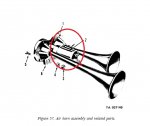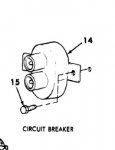Let's make this easier
Hey Tin. Maybe I can help a bit. Been reading this thread and might have something to add as I do this kind of stuff for a living. First off, don't add complication with wire numbers, etc, at this point. Make sure you know how to use your meter and that you understand the volts and ohms functions. Put the meter to the ohms mode and touch the leads together. It will probably read "point something". This will be representing a dead short and tests the meter leads.
1. Pop off the horn button. If it's like most vehicles, there will be a wire to a contact. Measure with your meter (volts mode) from the contact to a good, clean ground. If you have 24vdc there, all is probably good.
2. Connect the contact to ground with a jumper wire. Horn blows = problem with horn button. Horn doesn't blow = troubleshooting time.... Go to #3.
3. Remove the connectors from the horn solenoid leaving the jumper at the horn button connected. One wire should have 24v on it, the other should show continuity to ground. No continuity to ground = bad wire or connection to horn button. No 24v = bad wire or connection from circuit breaker to horn.
4. If #3 is good, measure in ohms mode between the two terminals on the horn solenoid. Will be anywhere between about 10 ohms and maybe 200 ohms, depending upon exactly what type of solenoid is installed. Doesn't really matter, as long as there is something there. No ohms reading = bad solenoid.
5. The only other possibility would be a circuit breaker that does not work under load. In this case, make a jumper at the solenoid from the hot wire you found in #3 to the solenoid terminal where the wire was. Ensure the other wire is hooked up to the solenoid. Remove the jumper at the horn button and reinstall the button. Measure volts from the jumper wire while pushing the horn button. If the voltage drops a bunch, it's probably a poor connection in the hot wire somewhere or a bad breaker.
Hope this helps....
Note that all this depends on good, clean grounds. Paint/rust/dirt is NOT a good ground. You are measuring, volts or ohms, between two points. If your leads do not make good contact, you won't get a valid reading, period.




